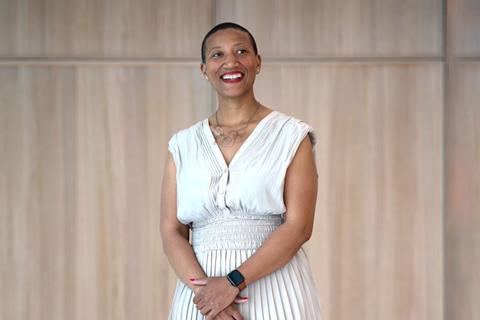“My biggest career challenge is wanting to do so many different things and having to prioritise them,” says Kimberly Dowdell, the American Institute of Architects (AIA) 2024 president and director of strategic relationships at architecture firm HOK.
This urge to do as much as she can in the industry she is so passionate about is clear when speaking to Dowdell – who is in the midst of juggling her year long stint as AIA president with her responsibilities at HOK. Neither is a small ask.

The AIA role sees her lead an organisation of 98,000 architects and affiliated professionals, across 200 chapters mostly in the US but also elsewhere in the world. At HOK she is responsible for ensuring that its 26 global studios are connecting and working together, as well as with clients, in a cohesive manner.
On top of this, she holds another role within the firm as a co-chair of its diversity advisory council – leading on HOK’s approaches and policies for diversity, equity and belonging.
>> Special report: Women in construction
If her current volume of work is not enough to show Dowdell’s unquestionable love for the architecture industry, her path into the sector definitely does.
Asked when she was first drawn to architecture, Dowdell says she was in middle school.
“When I was growing up, Detroit was experiencing quite a bit of disinvestment and beautiful buildings were falling into disuse,” she explains.
“I had just learnt in art class in middle school what an architect was, and I couldn’t help but think: if I become an architect, I can help this.”
She says that her initial idea on how to do this, which she now describes as reactivating boarded-up buildings in Detroit, saw her first attain an architecture degree at Cornell University – the only institution in the Ivy League to offer a bachelor of architecture degree – and then take a master’s in public administration, urban policy and real estate development at Harvard Kennedy School.
Given this background, it is perhaps unsurprising that Dowdell sees it as a professional responsibility to ensure that architecture is doing good.
She says: “I see the role of the architect as being to plant the seeds of what is possible; they need to be very conscious of doing good for the community they are looking to serve.” This is why she is using her year as AIA president to advocate for cities to have chief architect positions, explains Dowdell.
She says having a chief architect advise mayors on issues such as climate action, affordable housing and health equity could be invaluable in delivering good through projects.
For similar reasons, she says, it is imperative to grow the number of women and those from other under-represented demographics in the profession.
“The architecture profession should reflect the community they are looking to serve. That’s the reason I have done the work I have done,” she says.
In terms of attracting women into the industry, she says there is still some way to go.
“It is important people can see role models they can relate to in leadership positions; it’s part of the reason I ran for AIA president,” Dowdell explains.
She is the first millennial president of the AIA, meaning she is a role model for not only women and people of colour but also the next generation of architects. “We aren’t seeing those groups elevated, so I hope that providing visibility shows there are pathways,” she says.



























No comments yet